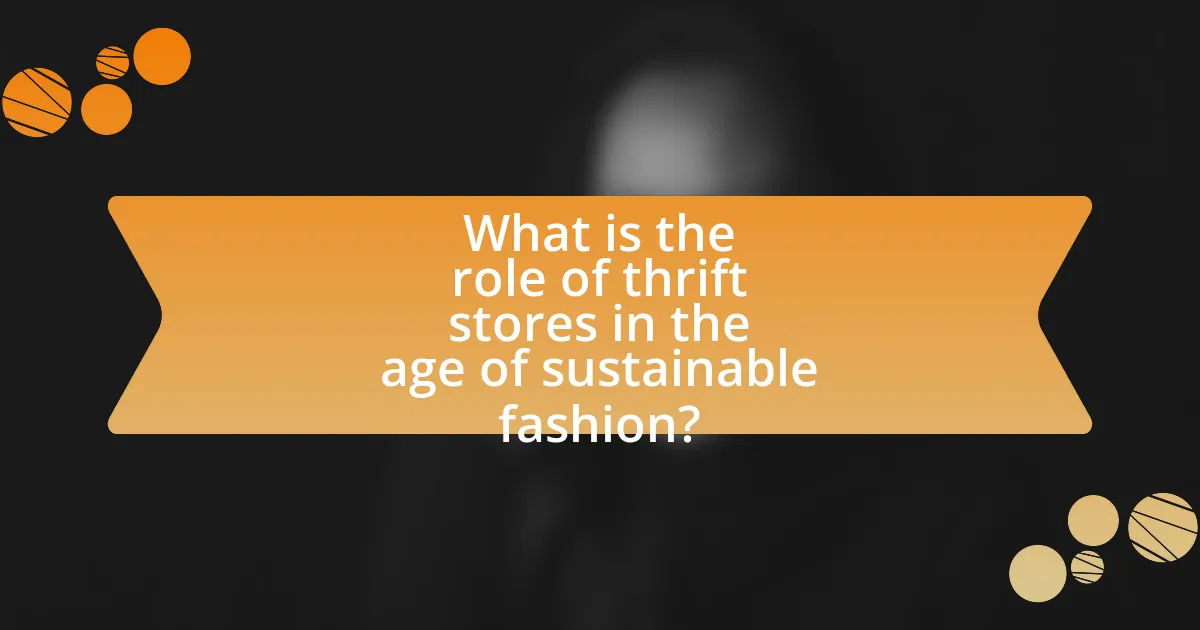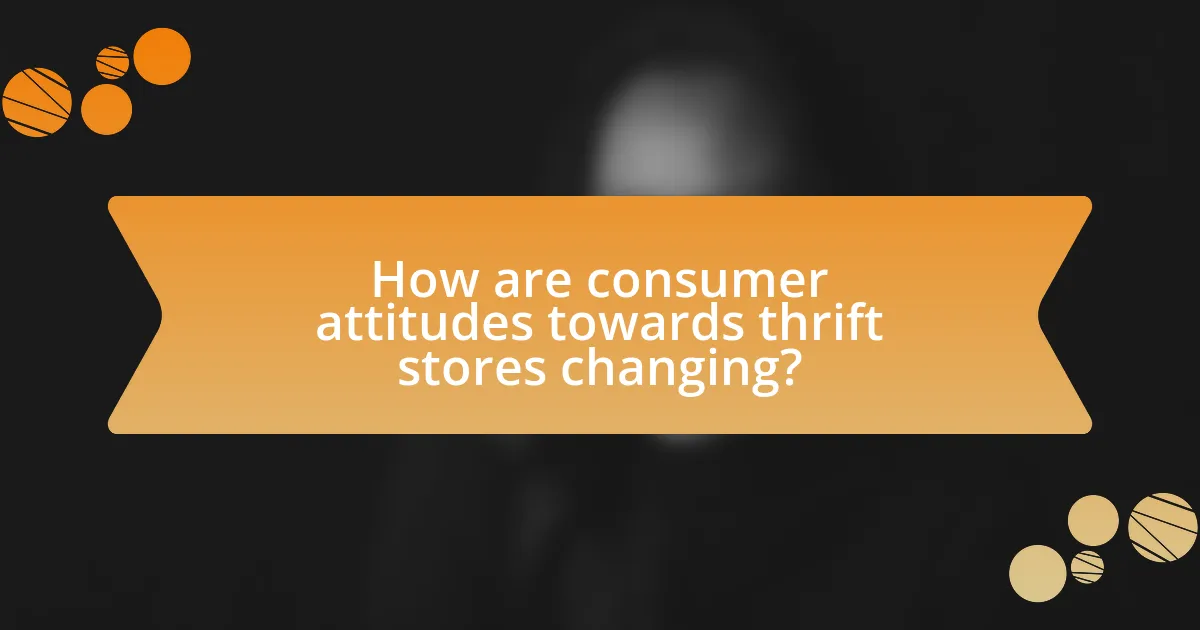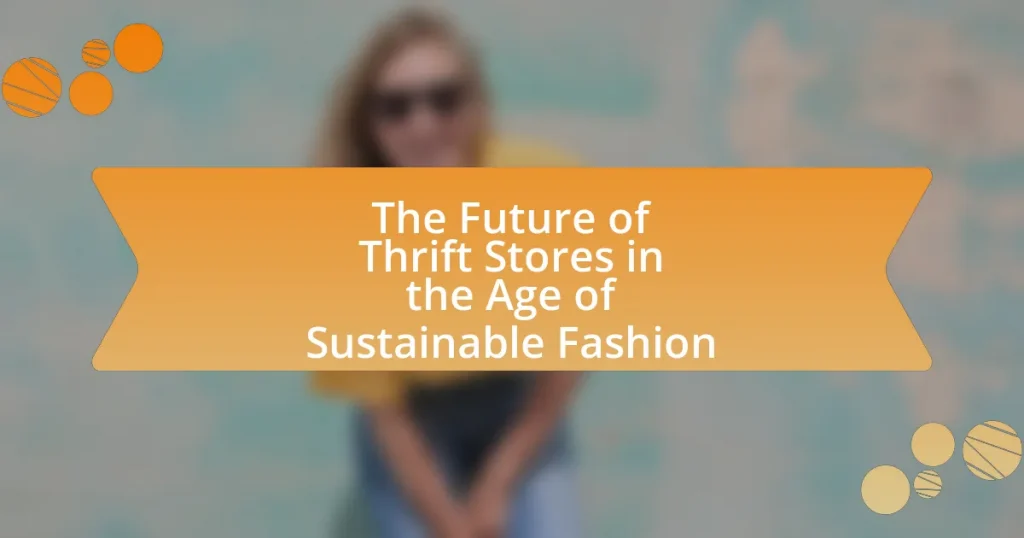Thrift stores are increasingly recognized as vital components of sustainable fashion, promoting the reuse and recycling of clothing to reduce waste and environmental impact. This article explores the significant role thrift stores play in extending the lifecycle of garments, mitigating carbon emissions, and supporting local communities. It also addresses the challenges these stores face, including competition from fast fashion and online marketplaces, while highlighting the changing consumer attitudes towards thrift shopping, particularly among younger generations. Additionally, the article examines the innovations and strategies thrift stores can adopt to enhance customer experience and operational efficiency in a rapidly evolving retail landscape.

What is the role of thrift stores in the age of sustainable fashion?
Thrift stores play a crucial role in the age of sustainable fashion by promoting the reuse and recycling of clothing, thereby reducing waste and environmental impact. These stores provide an accessible platform for consumers to purchase second-hand items, which extends the lifecycle of garments and minimizes the demand for new production. According to a report by the Ellen MacArthur Foundation, the fashion industry is responsible for 10% of global carbon emissions, and thrift shopping can significantly mitigate this by diverting textiles from landfills. Furthermore, thrift stores often support local communities and charities, reinforcing the social aspect of sustainability.
How do thrift stores contribute to sustainable fashion practices?
Thrift stores contribute to sustainable fashion practices by promoting the reuse and recycling of clothing, which reduces waste and the demand for new garment production. By offering second-hand items, thrift stores extend the lifecycle of clothing, thereby minimizing the environmental impact associated with manufacturing processes, such as water consumption and carbon emissions. According to the Environmental Protection Agency, textile recycling can divert millions of tons of waste from landfills each year, highlighting the significant role thrift stores play in fostering a circular economy in fashion.
What are the environmental benefits of shopping at thrift stores?
Shopping at thrift stores significantly reduces environmental impact by promoting recycling and minimizing waste. Thrift stores extend the lifecycle of clothing and goods, which decreases the demand for new production, thereby conserving resources such as water and energy. According to the Environmental Protection Agency, textile recycling can save approximately 3,000 gallons of water per ton of fabric, highlighting the substantial resource savings associated with purchasing second-hand items. Additionally, by diverting items from landfills, thrift shopping helps reduce landfill overflow, which is a major contributor to greenhouse gas emissions. Thus, shopping at thrift stores supports sustainable practices and contributes to a healthier environment.
How do thrift stores promote circular fashion?
Thrift stores promote circular fashion by facilitating the reuse and recycling of clothing, thereby extending the lifecycle of garments. By selling second-hand items, thrift stores reduce the demand for new clothing production, which is resource-intensive and contributes to environmental degradation. According to a report by the Ellen MacArthur Foundation, extending the life of clothing by just nine months can reduce carbon, water, and waste footprints by 20-30%. This demonstrates how thrift stores play a crucial role in minimizing waste and promoting sustainable consumption practices.
What challenges do thrift stores face in the current fashion landscape?
Thrift stores face significant challenges in the current fashion landscape, primarily due to increased competition from fast fashion retailers and online marketplaces. Fast fashion brands offer trendy clothing at low prices, which can divert consumers away from thrift stores. Additionally, the rise of e-commerce platforms like Poshmark and Depop allows individuals to sell second-hand items directly, intensifying competition. According to a report by ThredUp, the second-hand market is projected to reach $64 billion by 2024, highlighting the growing demand but also the competitive pressure thrift stores must navigate. Furthermore, thrift stores often struggle with inventory management and sourcing quality items, as the influx of donations can be inconsistent and unpredictable. These factors collectively challenge thrift stores to adapt and innovate in order to remain relevant in a rapidly evolving fashion environment.
How does competition from fast fashion impact thrift stores?
Competition from fast fashion negatively impacts thrift stores by reducing the demand for second-hand clothing. Fast fashion brands offer trendy, low-cost apparel that attracts consumers seeking new items, leading to a decline in foot traffic and sales for thrift stores. According to a 2021 report by ThredUp, the resale market is projected to grow to $64 billion by 2024, but fast fashion continues to dominate the retail landscape, with brands like Zara and H&M producing millions of garments annually. This oversaturation of inexpensive new clothing diminishes the perceived value of thrifted items, making it challenging for thrift stores to compete effectively.
What are the operational challenges thrift stores encounter?
Thrift stores encounter several operational challenges, including inventory management, staffing issues, and competition from online resale platforms. Inventory management is particularly complex due to the unpredictable nature of donations, which can lead to either surplus or shortages of goods. Staffing challenges arise from the need for trained volunteers or employees who can manage the store effectively while maintaining a positive customer experience. Additionally, competition from online resale platforms has intensified, as consumers increasingly prefer the convenience of shopping online, which can reduce foot traffic in physical thrift stores. These challenges necessitate strategic planning and adaptation to ensure sustainability and growth in the evolving landscape of sustainable fashion.

How are consumer attitudes towards thrift stores changing?
Consumer attitudes towards thrift stores are increasingly positive, driven by a growing awareness of sustainability and environmental impact. Many consumers now view thrift shopping as a viable alternative to fast fashion, recognizing that purchasing second-hand items reduces waste and promotes recycling. According to a 2021 survey by ThredUp, 70% of consumers reported that they are more likely to shop second-hand due to environmental concerns. This shift in perception is also reflected in the rise of social media influencers promoting thrift shopping, further normalizing and popularizing the practice among younger demographics.
What factors are influencing the rise in popularity of thrift shopping?
The rise in popularity of thrift shopping is primarily influenced by increasing consumer awareness of sustainability and environmental issues. As more individuals recognize the negative impact of fast fashion on the planet, they are turning to thrift stores as a more eco-friendly alternative. According to a 2021 survey by ThredUp, 70% of consumers reported that sustainability is a key factor in their shopping decisions, leading to a significant increase in thrift store patronage. Additionally, the unique and diverse inventory found in thrift shops appeals to consumers seeking individuality in their fashion choices, further driving interest.
How does social media affect perceptions of thrift stores?
Social media significantly enhances positive perceptions of thrift stores by promoting sustainability and unique fashion finds. Platforms like Instagram and TikTok showcase thrifted outfits, encouraging users to view thrift stores as trendy and eco-friendly alternatives to fast fashion. A study by ThredUp found that 70% of consumers are influenced by social media when shopping for secondhand items, highlighting the role of influencers and user-generated content in shaping these perceptions. This visibility not only increases foot traffic to thrift stores but also fosters a community that values sustainable shopping practices.
What role do influencers play in promoting thrift shopping?
Influencers play a significant role in promoting thrift shopping by leveraging their platforms to showcase sustainable fashion choices. They create awareness about the environmental benefits of thrift shopping, such as reducing waste and promoting circular fashion. For instance, a study by the Ellen MacArthur Foundation highlights that extending the life of clothing by just nine months can reduce carbon, water, and waste footprints by 20-30%. Influencers often share their thrifted finds, styling tips, and personal stories, which resonate with their followers and encourage them to explore thrift stores. This engagement not only drives traffic to thrift shops but also fosters a community around sustainable fashion practices.
Why are younger generations gravitating towards thrift stores?
Younger generations are gravitating towards thrift stores primarily due to their commitment to sustainability and unique fashion finds. This demographic increasingly values eco-friendly practices, as evidenced by a 2021 survey from ThredUp, which found that 70% of Gen Z consumers prefer to buy secondhand to reduce environmental impact. Additionally, thrift stores offer distinctive and vintage clothing options that appeal to younger shoppers seeking individuality in their style, further driving their popularity.
What values do millennials and Gen Z associate with thrift shopping?
Millennials and Gen Z associate thrift shopping with sustainability, individuality, and affordability. These generations prioritize eco-friendly practices, viewing thrift shopping as a way to reduce waste and promote recycling in fashion. A study by ThredUp in 2021 indicated that 70% of Gen Z consumers are willing to pay more for sustainable products, highlighting their commitment to environmental values. Additionally, thrift shopping allows for unique fashion choices, enabling individuals to express their personal style distinctively. This emphasis on individuality is supported by a 2020 survey from McKinsey, which found that 67% of Gen Z prefers brands that reflect their personal values. Lastly, affordability remains a key factor, as both generations seek budget-friendly options without compromising on style.
How does thrift shopping align with the lifestyle choices of younger consumers?
Thrift shopping aligns with the lifestyle choices of younger consumers by promoting sustainability and individuality. Younger consumers increasingly prioritize eco-friendly practices, with 72% of millennials and Gen Z stating they prefer to buy from sustainable brands, according to a 2021 survey by McKinsey & Company. Thrift shopping allows them to reduce waste and support circular fashion, which resonates with their values of environmental consciousness. Additionally, the unique and diverse offerings in thrift stores enable younger shoppers to express their personal style, differentiating them from mass-produced fashion. This combination of sustainability and self-expression makes thrift shopping a popular choice among younger demographics.

What innovations are shaping the future of thrift stores?
Innovations shaping the future of thrift stores include the integration of technology, such as online platforms and mobile apps, which enhance customer engagement and streamline inventory management. For instance, platforms like ThredUp and Poshmark allow users to buy and sell second-hand items online, significantly expanding the market reach of thrift stores. Additionally, the use of data analytics helps thrift stores optimize pricing strategies and inventory turnover, leading to increased sales. According to a report by ThredUp, the second-hand market is projected to reach $64 billion by 2024, indicating a growing consumer preference for sustainable shopping options. These technological advancements not only improve operational efficiency but also align with the rising demand for eco-friendly fashion solutions.
How are technology and e-commerce transforming thrift shopping?
Technology and e-commerce are transforming thrift shopping by enhancing accessibility, expanding inventory, and improving customer engagement. Online platforms allow thrift stores to reach a broader audience, enabling consumers to shop from anywhere, which increases sales opportunities. For instance, platforms like ThredUp and Poshmark have reported significant growth, with ThredUp’s 2021 report indicating a 24% increase in online thrift shopping. Additionally, technology facilitates better inventory management through data analytics, allowing thrift stores to optimize their offerings based on consumer demand. This shift not only promotes sustainable fashion by extending the lifecycle of clothing but also caters to a growing consumer preference for eco-friendly shopping options.
What are the benefits of online thrift shopping platforms?
Online thrift shopping platforms offer several benefits, including convenience, cost savings, and sustainability. These platforms allow consumers to shop from the comfort of their homes, providing access to a wide variety of second-hand items without geographical limitations. Cost savings are significant, as thrifted items are typically priced lower than new products, making fashion more affordable. Additionally, online thrift shopping supports sustainable fashion by promoting the reuse of clothing, which reduces waste and the environmental impact associated with fast fashion. According to a report by the Ellen MacArthur Foundation, extending the life of clothing by just nine months can reduce carbon, water, and waste footprints by 20-30%.
How can thrift stores leverage technology for inventory management?
Thrift stores can leverage technology for inventory management by implementing inventory management software that tracks stock levels, sales trends, and item locations in real-time. This technology allows thrift stores to optimize their inventory turnover rates, reduce overstock and stockouts, and enhance the overall shopping experience. For instance, using barcode scanning systems can streamline the check-in and check-out processes, making it easier to manage incoming donations and sales. According to a report by the National Association of Resale and Thrift Shops, stores that utilize technology for inventory management see a 20-30% increase in efficiency, demonstrating the tangible benefits of adopting such systems.
What strategies can thrift stores adopt to enhance customer experience?
Thrift stores can enhance customer experience by implementing personalized shopping services, such as curated selections based on customer preferences. This strategy allows stores to cater to individual tastes, increasing customer satisfaction and loyalty. Research indicates that personalized experiences can lead to a 20% increase in customer engagement, as shoppers feel more valued and understood. Additionally, thrift stores can improve the shopping environment by organizing merchandise effectively and creating inviting displays, which has been shown to boost sales by up to 30%. By adopting these strategies, thrift stores can significantly enhance the overall customer experience.
How can thrift stores create a unique shopping environment?
Thrift stores can create a unique shopping environment by curating a diverse selection of items that reflect local culture and trends. This approach not only attracts a varied customer base but also fosters a sense of community. For instance, incorporating themed sections or hosting events can enhance the shopping experience, making it more engaging. Research indicates that stores that offer interactive experiences, such as DIY workshops or fashion shows, see increased customer satisfaction and loyalty. By emphasizing sustainability and storytelling behind each item, thrift stores can further differentiate themselves, appealing to environmentally conscious consumers.
What marketing strategies can thrift stores implement to attract more customers?
Thrift stores can implement targeted social media marketing to attract more customers. By utilizing platforms like Instagram and Facebook, thrift stores can showcase unique items, promote special sales, and engage with the community. Research indicates that 54% of social media users use these platforms to research products, making it essential for thrift stores to maintain an active online presence. Additionally, hosting community events or collaborations with local artists can enhance visibility and foster customer loyalty, as 70% of consumers prefer to support businesses that engage with their local community.
What practical tips can consumers follow to maximize their thrift shopping experience?
To maximize their thrift shopping experience, consumers should prioritize visiting stores frequently and at various times to find the best selection. Thrift stores often receive new inventory daily, and shopping regularly increases the chances of discovering unique items. Additionally, consumers should come prepared with a list of specific items they need, which helps focus their search and prevents impulse buys. Research indicates that shoppers who have a clear goal tend to make more satisfying purchases. Furthermore, trying on clothes is essential, as sizes can vary significantly between brands and eras, ensuring a better fit. Lastly, consumers should embrace the idea of upcycling or repurposing items, as this not only enhances creativity but also aligns with sustainable fashion practices, which are increasingly important in today’s retail landscape.



